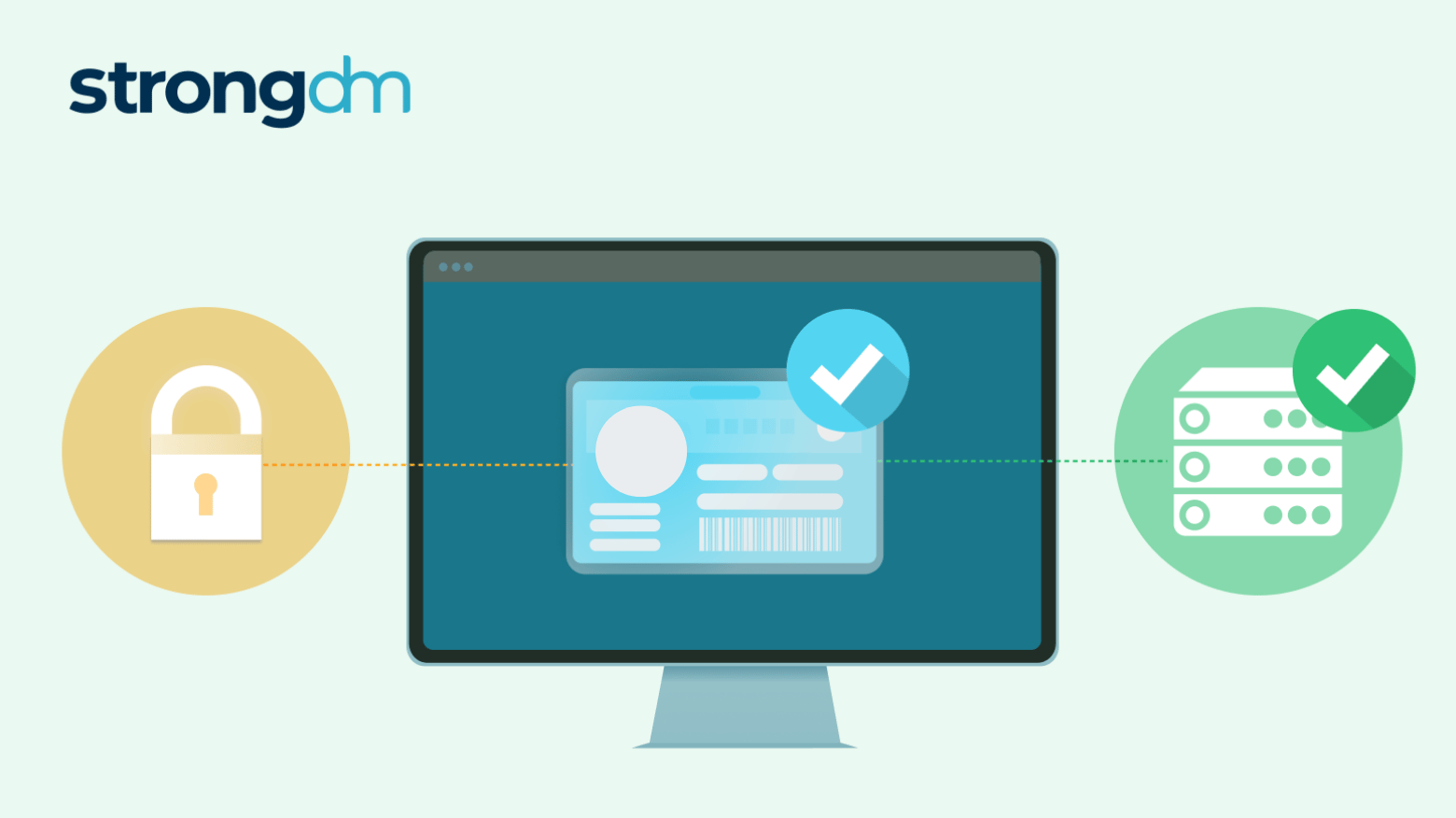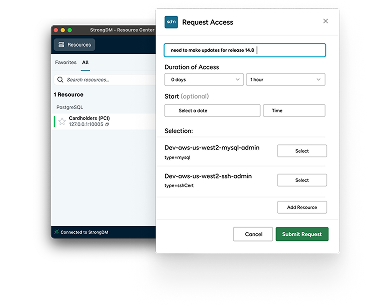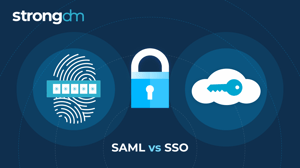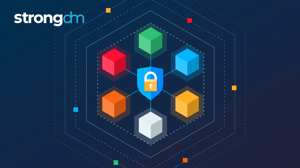What Is Context-Aware Authentication? Examples & How It Works


Written by
John MartinezLast updated on:
August 19, 2025Reading time:
Contents
Built for Security. Loved by Devs.
- Free Trial — No Credit Card Needed
- Full Access to All Features
- Trusted by the Fortune 100, early startups, and everyone in between
Passwords alone don’t stop breaches anymore. Context-aware authentication changes the game by using real-time signals like device, location, time, and behavior to decide whether access should be granted.
It’s adaptive, risk-based, and built for today’s zero-trust world.
This guide explains how context-aware auth works, why it outperforms static rules, and where it fits into your security strategy. And if you’re serious about enforcing it across infrastructure, StrongDM makes it turnkey. With StrongDM, you can automatically apply access policies based on device posture, session timing, group membership, or any other context.
What Is Context-Aware Authentication?
Context-aware authentication is a security method that involves reviewing contextual clues when choosing whether to grant a user access to protected systems. Doing this can help you catch bad actors more consistently and thwart their attacks before they ever start.
Understanding Context in Authentication
Authentication has been a central pillar of cybersecurity since the field’s earliest days. But traditional methods, like validating a user’s password, leave gaps that hackers can exploit. Taking context into consideration can fill these gaps to keep your business safe.
What “Context” Means
In the field of authentication, context refers to any user information that can help you identify whether they’re valid and should be admitted to your private network. This includes:
- User location: Based on IP address, geo-fencing rules, and physical location
- Device used: Primarily considering whether the device has accessed the network safely in the past
- Time of access: The day and time that a user attempts to log in, considering whether it aligns with their previous access history
- Network and IP address: Do these match the user’s history? Are they connecting from a known corporate network or a public WiFi network?
- Behavioral patterns: Reviewing user activity logs for discrepancies, like their typing speed, navigation habits, and past login patterns
These contextual clues can increase your confidence level when admitting users to private systems. For example, you’re more likely to admit a valid user when their time of access, device used, and IP address match the account’s history than you would be if you only checked their username and password.
Traditional vs. Context-Aware Authentication
This table compares context-aware access policies with traditional authentication methods. It’s a visual summary of what you’ve read so far.
| Feature | Traditional Authentication | Context-Aware Authentication |
| Static Rules | Yes | No |
| Evaluates Risk | No | Yes |
| Adapts to Situations | No | Yes |
| Example | Username + Password | Device + Location + Behavior |
How Context-Aware Authentication Works
Contextual authentication can help your business protect itself from hackers. But how does the process work in practice? Here are three key components.
Risk-Based Scoring
First, contextual authentication typically involves risk-based scoring. This means assigning a numerical score to every contextual authentication signal, adding those together, and considering whether the sum exceeds a meaningful threshold.
For example, on a 0-100 risk scale with 100 representing maximum risk, a risk over 80 may lead to automatic denial, while one between 60 and 79 could prompt a challenge. In this case, that challenge could mean requesting multi-factor authentication, asking security questions, or taking some other action to validate the login attempt further. You would automatically deny any score below 60 in this system.
Risk-based scoring is helpful because it considers every contextual clue without making any of them entirely definitive. This helps you consistently evaluate every factor that contributes to access risk without falling into habits or patterns that a hacker could potentially exploit. For example, if you become too reliant on a metric like a user's device, someone may be able to exploit that by taking control of the device. You could miss the warning signs of such an attack without a robust risk scoring system.
Integration with MFA
Many teams also integrate their strategy with multi-factor authentication. For example, a context-aware system could automatically trigger MFA only when it’s needed based on risk scoring. This reduces friction for the average user without compromising the protection MFA offers when needed.
Adaptive MFA can also increase requirements for highly suspicious login attempts. For example, if a user has a risk score over 90/100, you might ask for more than just an SMS code. You could also request biometric verification, confirmation from a system administrator, or another heightened form of proof.
Real-Time Decisioning
Context-aware systems enable more real-time decision-making around security. They help you take extra precautions when needed without totally disrupting the user experience for the average employee. That means enhanced security for your business without a corresponding loss in efficiency.
These systems can also help you respond to threats faster as they emerge in real time. For example, an alert showing a suspicious log-in attempt can be your first sign of a pending attack. When you have a context-aware system in place, these early warning signs become easier to find and act on before any serious damage can take place.
Benefits of Context-Aware Authentication
Setting up contextual authentication costs money, which means you’ll need to be able to justify the expense. Here are some of the key benefits you’ll get in exchange for your investment:
- Enhanced security: Your company will significantly improve at detecting and stopping credential misuse, phishing, and unauthorized lateral movement.
- Improved UX: As you become more adept at detecting unauthorized access, it minimizes interruptions for the average user, enhancing their experience within the system.
- Reduced false positives: You’ll lock out fewer legitimate users when you upgrade from static policies. That reduces frustration and improves efficiency by ensuring trusted users can access the systems they need more consistently.
- Compliance readiness: Contextual authentication can also be a critical step toward earning valuable compliance certifications. It supports the principle of least privilege, zero trust, and auditability.
Context-Aware Authentication Examples (Use Cases)
As you think about how to apply context-aware authentication to your cybersecurity framework, it’s worth considering a few real-world examples.
Remote Work and BYOD
First, remote teams and companies that allow employees to bring their own devices to work can set different authentication rules based on key user differences. For example, a company might decide to authenticate users differently based on whether they’re accessing an internal network on a corporate device or their personal laptop.
Similarly, companies often adapt their polices based on geography and working hours. For example, you may have a more stringent authentication process for a remote team in Europe than your in-house staff. Contextual systems enable this, helping you increase security where needed without disrupting daily users.
DevOps and Engineering Teams
Contextual authentication systems also enable different security rules depending on the team. You can use this in various ways to protect your assets. For example, many companies offer conditional access to infrastructure based on roles and environments.
For example, you might allow internal engineering teams to access your new platform when it’s in production. But outsourced developers may only need to connect during the staging process. This kind of conditional access can help keep your business safe through the application of the principle of least privilege.
Third-Party Vendors and Contractors
Finally, context-aware authentication lets you grant access to third-party vendors and contractors on an extremely limited basis. This can give them the information they need to complete their job without seriously increasing your risk in the process. It can help you stay safe while still benefiting from the advantages companies often find through outsourcing.
Challenges with Context-Aware Authentication
Contextual authentication is better than the alternative because it gives you more insight into whom you're admitting into your private systems. However, it’s not without challenges. You may experience some of the following during your implementation process:
- Privacy concerns: Some of your users may be unhappy about you collecting their location data. You may want to draft a policy explaining how you’ll use it to keep these concerns in check.
- Complexity in policy configuration: Setting up contextual controls can be challenging. It requires intelligent default settings and fine-grained control over a variety of technical information. You may need third-party help when getting started.
- Integration overhead: Finally, not all legacy systems support contextual signals. You may need to upgrade parts of your digital infrastructure to unlock the full benefits of context-aware authentication.
How Context-Aware Authentication Supports Zero Trust
The zero-trust philosophy is among the most influential in the cybersecurity field. It essentially says that you should never trust, but always verify. In other words, don’t grant access based on a user’s static credentials, but continuously assess their trust levels with real-time signals. Context-aware authentication makes it easier to embrace a zero-trust approach.
It gives you the technical infrastructure you need to assess real-time metrics around user behavior, device type, location, and network context. This not only keeps your business safe, but it also lays the foundation you'll need to pursue valuable cybersecurity certifications. So, context-aware authentication is a pathway to zero-trust cybersecurity, which can prepare your company to achieve major compliance goals.
Why StrongDM Is the Clear Choice for Context-Aware Authentication
Adopting context-aware authentication shouldn’t mean wrestling with complex policy engines, legacy integrations, or frustrated users. StrongDM makes it simple, scalable, and future-proof:
- Adaptive, Risk-Based Access: Define policies once and let StrongDM automatically adjust authentication based on device posture, location, time of access, user behavior, and more.
- Seamless User Experience: Cut down on unnecessary MFA prompts while still tightening security. StrongDM only enforces additional steps when the risk is high.
- Zero Trust, Made Practical: Every access decision is continuously evaluated against context, helping you implement zero trust without slowing down your business.
- Granular Policy Control: Apply different rules for employees, contractors, vendors, and remote workers without adding administrative overhead.
- Compliance Ready: Strengthen audit trails, enforce least privilege, and align with frameworks like HIPAA, SOC 2, ISO 27001, and more.
Passwords are not enough. Context-aware authentication is the future, and StrongDM makes it turnkey.
Book a demo today and see how StrongDM can help you secure every connection without compromising speed or usability.
Next Steps
StrongDM unifies access management across databases, servers, clusters, and more—for IT, security, and DevOps teams.
- Learn how StrongDM works
- Book a personalized demo
- Start your free StrongDM trial

Categories:

About the Author
John Martinez, Technical Evangelist, has had a long 30+ year career in systems engineering and architecture, but has spent the last 13+ years working on the Cloud, and specifically, Cloud Security. He's currently the Technical Evangelist at StrongDM, taking the message of Zero Trust Privileged Access Management (PAM) to the world. As a practitioner, he architected and created cloud automation, DevOps, and security and compliance solutions at Netflix and Adobe. He worked closely with customers at Evident.io, where he was telling the world about how cloud security should be done at conferences, meetups and customer sessions. Before coming to StrongDM, he lead an innovations and solutions team at Palo Alto Networks, working across many of the company's security products.
You May Also Like




